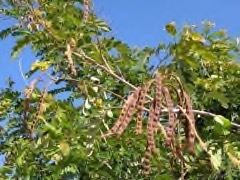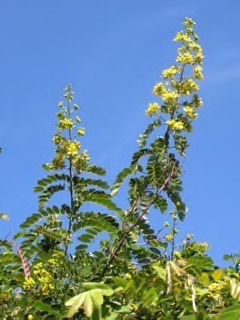 |
|
N. Juergens; Photo Guide to Plants of Southern African plants. BioCentre Klein Flottbek, Hamburg, Germany |
 |
| N. Juergens; Photo Guide to Plants of Southern African plants. BioCentre Klein Flottbek, Hamburg, Germany |
Translate this page:
Summary
Physical Characteristics

 Senna singueana is a deciduous Tree growing to 5 m (16ft) by 4 m (13ft) at a fast rate.
Senna singueana is a deciduous Tree growing to 5 m (16ft) by 4 m (13ft) at a fast rate.
See above for USDA hardiness. It is hardy to UK zone 10. The flowers are pollinated by Bees.
It can fix Nitrogen.
Suitable for: light (sandy), medium (loamy) and heavy (clay) soils and prefers well-drained soil. Suitable pH: mildly acid, neutral and basic (mildly alkaline) soils. It cannot grow in the shade. It prefers moist soil.
UK Hardiness Map
US Hardiness Map
Synonyms
Cassia goratensis Fresen. Cassia kethulleana De Wild. Cassia mututu De Wild. Cassia sabak Delile Cassia singueana Delile Cassia tettensis Bolle Cassia zanzibarensis Vatke
Plant Habitats
Edible Uses
Edible Parts: Leaves Seedpod
Edible Uses: Coffee
Pods - raw or cooked[303 ]. Fleshy and sweet[398 ]. They are collected as soon as they are ripe, broken open, the sweet pulp sucked out and the seeds discarded[398 ]. They are mostly eaten by children and herdsmen[398 ]. The seeds are used as a substitute for coffee[398 ]. The leaves are eaten as a cooked vegetable in Malawi and Tanzania, but elsewhere they are considered to be poisonous[299 ].
References More on Edible Uses
Medicinal Uses
Plants For A Future can not take any responsibility for any adverse effects from the use of plants. Always seek advice from a professional before using a plant medicinally.
Analgesic Anthelmintic Antibacterial Antidiarrhoeal Antipyretic Antispasmodic Antitussive Antiviral
Astringent Epilepsy Galactogogue Laxative Leprosy Malaria Ophthalmic
Purgative Skin Stomachic
The plant has many medicinal uses throughout Africa[299 ]. Modern research has shown the presence of a range of medically active compounds. The roots contain 4 tetrahydroanthracene derivatives, singueanol-I and -II, torosachrysone and germichrysone, as well as the pentacyclic triterpene lupeol and steroids (campesterol, ß-sitosterol and stigmasterol). The anthracene derivatives have shown significant activity against several gram-positive bacteria in vitro and also antispasmodic activity[299 ]. Extracts of the root bark have shown significant analgesic, antipyretic, anthelmintic and antiplasmodial activity[299 ]. The leaves have been shown to have anthelmintic and antiviral properties, but no significant antibacterial activity[299 ]. The stem bark and leaves contain tannins and are astringent[299 ]. The leaves, stem and the root bark are all used as anthelmintics and to treat bilharzia[299 ]. An infusion of the leaves is used as a remedy for venereal disease, malaria, convulsions, epilepsy, coughs, intestinal worms, constipation, heartburn and stomach-ache[398 ]. A hot water infusion of the leaves is drunk and the warm leaves are applied as a compress to treat fever. The leaves, either as a decoction or infusion, or as a dried powder, are applied to wounds caused by leprosy and syphilis[299 ]. An infusion of the leaves is applied as eye drops to cure conjunctivitis[299 ]. A decoction of the roots is used to treat wounds and as a remedy for diarrhoea, convulsions, dementia and STDs[398 ]. The roots are used to treat venereal diseases, stomach complaints and as a purgative. The roots are also used to cure impotence caused by diabetes. The ash of burnt roots is eaten mixed with porridge to cure abdominal pain[299 ]. Extracts of the stem bark are taken to cure stomach complaints. Like the leaves, the stem bark is used to treat skin disorders and malaria[299 ]. An infusion of the flowers is used as an eye lotion[299 ]. The fruit pulp soaked in water and cooked with a staple food is eaten by lactating women as it is considered a galactagogue[299 ].
References More on Medicinal Uses
The Bookshop: Edible Plant Books
Our Latest books on Perennial Plants For Food Forests and Permaculture Gardens in paperback or digital formats.

Edible Tropical Plants
Food Forest Plants for Hotter Conditions: 250+ Plants For Tropical Food Forests & Permaculture Gardens.
More

Edible Temperate Plants
Plants for Your Food Forest: 500 Plants for Temperate Food Forests & Permaculture Gardens.
More

More Books
PFAF have eight books available in paperback and digital formats. Browse the shop for more information.
Shop Now
Other Uses
Charcoal Dye Fibre Fodder Fruit ripening Fuel Furniture Hair Soil conditioner Tannin Wood
Agroforestry Uses: The tree is used for soil improvement[398 ]. A nitrogen fixer. A suitable candidate for agroforestry in dry areas[398 ]. Other Uses: The stem bark is used as a dye for textile in Ethiopia and Zambia and for tanning hides in large parts of East Africa[299 ]. The fruits are used in Sudan for tanning skins[299 ]. The leaves contain the flavonoid leucopelargonidin, which has dyeing properties[299 ]. Bananas are wrapped in the leaves to speed ripening[299 ]. The root fibres are used in hairpieces[299 ]. The wood is pale brown in colour with a distinct grain[299 , 303 ]. It is used for hut building, small furniture, tool handles, spoons and carvings[299 , 364 , 398 ]. The wood is used for fuel and to make charcoal[299 , 364 , 398 ]. Fodder: Pod.
Special Uses
Carbon Farming Food Forest Nitrogen Fixer
References More on Other Uses
Cultivation details
Agroforestry Services: Nitrogen Fodder: Pod Management: Standard Regional Crop
A plant of low to moderate elevations in the drier tropics, where it can be found from sea level to over 2,000 metres. It is found mainly in areas where the mean annual temperature is from 25 - 30°c, and the mean annual rainfall is within the range 500 - 1,000mm[299 , 303 ]. A fast-growing plant[299 ]. The plant responds well to coppicing[299 , 303 ]. The plant is fairly susceptible to fire, though its thick bark does give it some protection[299 ]. Although many species within the family Fabaceae have a symbiotic relationship with soil bacteria, this species is said to be devoid of such a relationship and therefore does not fix atmospheric nitrogen[755 ].
Carbon Farming
-
Agroforestry Services: Nitrogen
Plants that contribute to nitrogen fixation include the legume family – Fabaceae.
-
Fodder: Pod
Fodder plants with pods.
-
Management: Standard
Plants grow to their standard height. Harvest fruit, seeds, or other products. Non-Destructive management systems.
-
Regional Crop
These crops have been domesticated and cultivated regionally but have not been adopted elsewhere and are typically not traded globally, Examples in this broad category include perennial cottons and many nuts and staple fruits.
References Carbon Farming Information and Carbon Sequestration Information
Temperature Converter
Type a value in the Celsius field to convert the value to Fahrenheit:
Fahrenheit:
The PFAF Bookshop
Plants For A Future have a number of books available in paperback and digital form. Book titles include Edible Plants, Edible Perennials, Edible Trees,Edible Shrubs, Woodland Gardening, and Temperate Food Forest Plants. Our new book is Food Forest Plants For Hotter Conditions (Tropical and Sub-Tropical).
Shop Now
Plant Propagation
Seed - pre-soak in warm water for 12 hours prior to sowing. The seed usually sprouts within 9 days of sowing, with around 78% germinating[299 ].
Other Names
If available other names are mentioned here
Scrambled egg (English) Sticky pod (English) Winter cassia (English) Winter-flowering senna (English). Busa, Hanqarar, Isihaqa esincinyane, Kadate, Kafungu-nasya, Mbaraka, Mhumba, Mkundekunde, Mlewelewe, Mliwaliwa, Mpatsachokolo, Msua, Mtogo, Muhasa, Mukengeka, Munzungunzungu, Mutungulu, Mwisa, Ndiapimbwa, Ntantanyerere, Ntewelewe, Nuhumba, Tawetawe
Native Range
AFRICA: Ethiopia, Sudan, Chad (south), Kenya, Tanzania, Uganda, Cameroon, Democratic Republic of the Congo, Rwanda, Burkina Faso, Côte D Ivoire, Ghana, Mali, Niger, Nigeria (north), Angola, Mozambique, Malawi, Zambia, Zimbabwe, Namibia (north), Comoros.
Weed Potential
Right plant wrong place. We are currently updating this section.
Please note that a plant may be invasive in one area but may not in your area so it's worth checking.
None Known
Conservation Status
IUCN Red List of Threatened Plants Status : This taxon has not yet been assessed

Growth: S = slow M = medium F = fast. Soil: L = light (sandy) M = medium H = heavy (clay). pH: A = acid N = neutral B = basic (alkaline). Shade: F = full shade S = semi-shade N = no shade. Moisture: D = dry M = Moist We = wet Wa = water.
Now available:
Food Forest Plants for Mediterranean Conditions
350+ Perennial Plants For Mediterranean and Drier Food Forests and Permaculture Gardens.
[Paperback and eBook]
This is the third in Plants For A Future's series of plant guides for food forests tailored to
specific climate zones. Following volumes on temperate and tropical ecosystems, this book focuses
on species suited to Mediterranean conditions—regions with hot, dry summers and cool, wet winters,
often facing the added challenge of climate change.
Read More
Expert comment
Author
(Delile) Lock
Botanical References
Links / References
For a list of references used on this page please go here
A special thanks to Ken Fern for some of the information used on this page.
Readers comment
| Add a comment |
|
If you have important information about this plant that may help other users please add a comment or link below. Only comments or links that are felt to be directly relevant to a plant will be included. If you think a comment/link or information contained on this page is inaccurate or misleading we would welcome your feedback at [email protected]. If you have questions about a plant please use the Forum on this website as we do not have the resources to answer questions ourselves.
* Please note: the comments by website users are not necessarily those held by PFAF and may give misleading or inaccurate information.
To leave a comment please Register or login here All comments need to be approved so will not appear immediately.
|
Subject : Senna singueana
|
|
|
|